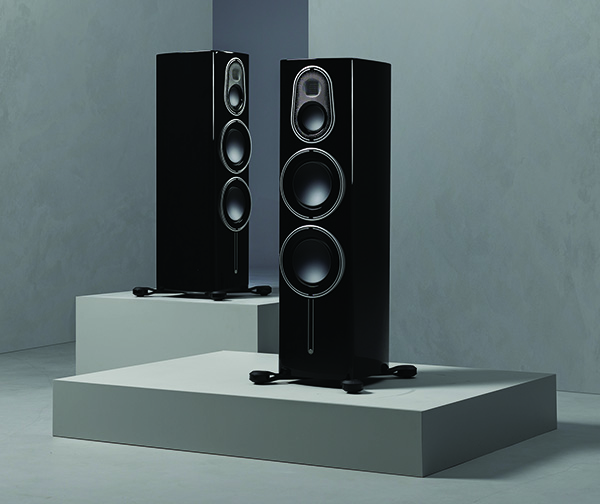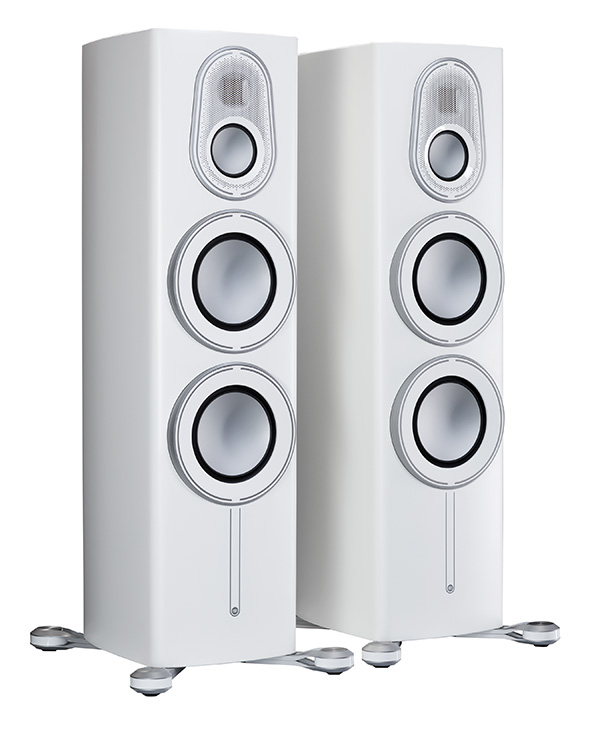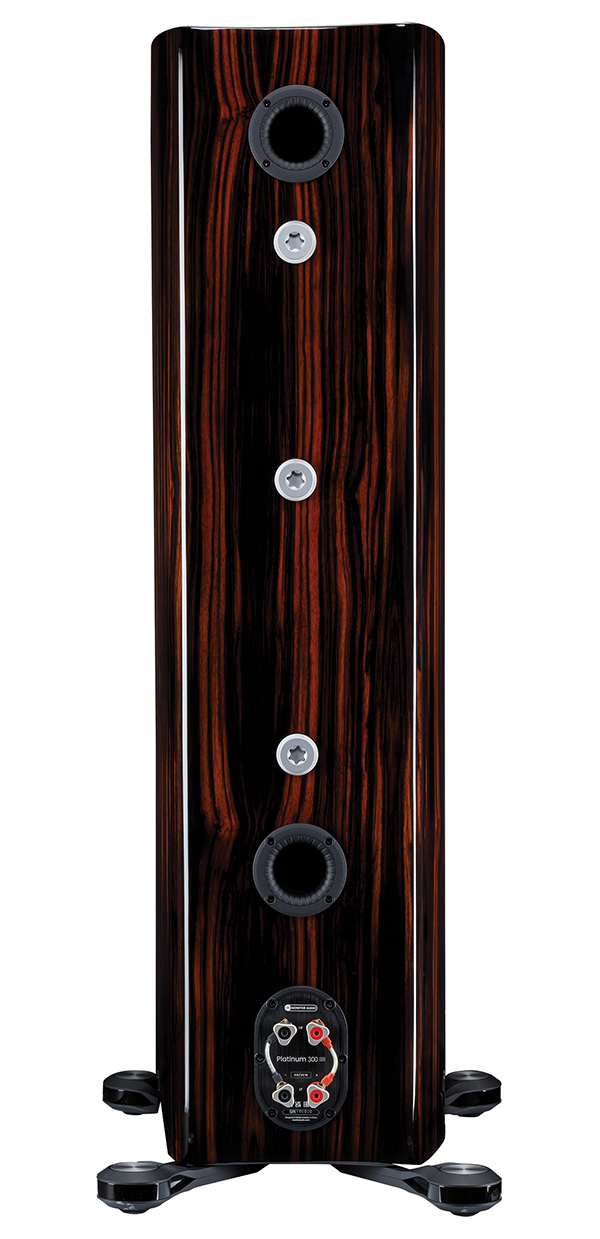| Columns Retired Columns & Blogs |
They haven't manufactured anything in Britain in a long time.


The Platinum 300 3G
With its elegant-looking enclosure featuring a gently curved front baffle and sidewalls and a concave rear panel, and its drive unit array of folded ribbon tweeter, 4" midrange unit, and two 8" woofers, Monitor Audio's Platinum 300 3G looks very similar to the Platinum PL300 II loudspeaker that Robert Deutsch reviewed in November 2016. Those speakers cost $14,496/pair back then; the 3Gs cost $17,900/pair, which, adjusted for inflation, is a lower price than that of its predecessor.
There are significant differences, however, all intended to reduce distortion and increase driver bandwidths. The new Micro Pleated Diaphragm (MPD) III tweeter, a variant of the Heil Air Motion Transformer (AMT), was developed for Monitor Audio's 50th Anniversary flagship Hyphn loudspeaker. The crossover from the midrange unit is set at 3kHz, and the tweeter's passband is said to extend to above 60kHz compared to >40kHz for a typical AMT tweeter. Monitor Audio's downloadable brochure mentions a gentle rise on-axis to maximize high-frequency detail. The square tweeter diaphragm is surrounded with a waveguide to control directivity.

The midrange unit operates from 650Hz to 3kHz. Both its cone and those of the woofers are made from a material Monitor Audio calls Rigid Diaphragm Technology (RDT) III. At the front of the three-layer diaphragm is a skin of ceramic-coated aluminum. Behind it lies a Nomex honeycomb, and behind that are two layers of carbon fiber to reduce cone breakup. The new units are said to have an optimized cone-edge treatment to extend their passbands, and the cones are terminated with inverse rubber surrounds.
The lower-frequency drive units are mounted in cast aluminum rings that isolate the driver chassis from the cabinet. There is no visible mounting hardware on the front baffle. Instead, there are bolt-through fixings that connect each driver to the rear panel while acting as a rigid brace. The termination of each bolt on the rear panel has a central Torx screw that can be used to ensure that the fixing hasn't worked loose in transit or use. A Torx key is included.
The curved, braced enclosure is made from laminated layers of MDF. The veneered finish is embellished with etched inlays before 16 layers of lacquer are added. The enclosure sits on four aluminum outriggers, which can be fitted with conical feet. The midrange unit is mounted in its own sealed subenclosure. The woofers are loaded with two gently flared rear-panel ports. Foam bungs are provided in case the 300 3G's low frequencies sound exaggerated in a small room or if the speakers have to be placed close to a room boundary, though Monitor Audio warns that only one port bung should be used for each speaker. Electrical connection is via two pairs of high-quality binding posts, connected with short jumper cables.

Setting up
Monitor Audio's informative manual recommends that the loudspeakers be positioned 6–10' feet apart, no closer than 3' from the sidewalls, and 12–24" from the wall behind them. The latter is not possible in my listening room due to there being two steps up to a vestibule behind the right-hand speaker. After some experimentation, the Platinum 300 3G's front baffles ended up 80" from the wall behind the speakers, the woofers 96" from each other. The right-hand woofers were 47" from the books that line that speaker's closest sidewall, and the left-hand woofers were 33" from the LPs that line that speaker's sidewall. The Platinum 300 3Gs were toed-in to the listening position, which was 127" away. Once I had settled on what I felt were the speakers' optimal positions, I screwed the downward-pointing cones into the outrigger feet.
The main source of music was my Roon Nucleus+ server feeding audio data over my network to an MBL N31 CD player/DAC, which was connected first to my regular Parasound Halo JC 1+ monoblocks then to the Naim 200 series NAP 250 that Martin Colloms reviews elsewhere in this issue. I also used my NAD M10 streaming integrated amplifier, followed by the Audio Research I/50 integrated amplifier I reviewed in September, then by the Musical Fidelity Nu-Vista 800.2 integrated amplifier that I will be reviewing for the December issue. The speakers were single-wired with AudioQuest Robin Hood cable.
Listening
The manual recommends that the Platinum 300 3Gs be used to play "normal music at low-mid listening levels for approximately 50–70 hours" to settle in. Accordingly, I used the speakers for a week's worth of casual playback before I started critical listening. I also checked with the supplied Torx key that the bolt-through driver fixings on the rear panel hadn't worked loose.

The dual-mono pink noise track on my Editor's Choice CD (STPH016-2; sold out) was reproduced as a stable central image. The noise sounded smooth and uncolored over most of the range, though the lowest bass was exaggerated. The half-step–spaced tonebursts on Editor's Choice spoke cleanly and evenly, though the lowest in frequency, at 32.7Hz, boomed, particularly from the right-hand speaker. When I listened to the 1/3-octave warble tones on Editor's Choice, the Platinum 300 3Gs cleanly reproduced the tones down to the 80Hz band, with the 63Hz, 50Hz, and 40Hz tones boosted in level. The 32Hz tone maximally excited the lowest-frequency room mode, and the 25Hz tone was more audible than I was expecting. I couldn't hear the 20Hz tone at my usual listening level. There was no audible wind noise from the ports. The warble tones sounded clean, with no distortion, and listening to the enclosure's walls with a stethoscope as the tonebursts played, I heard no liveliness.

They haven't manufactured anything in Britain in a long time.

Monitor Audio Linkedin page lists out that it has 76 employees including 62 employees in United Kingdom. I would guess it does not have a manufacturing facility in U.K., but outsource the manufacturing. But, personally it looks like a British company to me since 80% of employees are in U.K.
https://www.linkedin.com/company/monitor-audio-ltd/people/
On other hand, KEF Linkedin page has 303 employees world wide including 40 in United Kingdom. Again, I would assume there is no manufacturing facility in U.K. And, I wouldn't personally call it a British company although who cares about my personal opinion.
https://www.linkedin.com/company/kef/people/
But, who knows. These companies might use different matrix. Monitor Audio may have a parent company with a totally different legal name, and I would not know it by doing a quick search. The editors in Stereophile must have better insight, but I doubt anyone will ever mention it. Anyway, in the modern days, there are Asian companies under Western company brands/shells. Not saying it's wrong. Just an observation.

With 40 employees in U.K., I would personally doubt they do any meaningful manufacturing in U.K.
Bowers & Wilkins has 365 employees world wide including 185 in United Kingdom. Undoubtedly, I will call it a British company. And, I'm very surprised that KEF is as big as B&W in terms of the employee counts.
https://www.linkedin.com/company/bowerswilkins/people/

KEF's Muon, Blade and Reference loudspeakers are all made in Maidstone, England. That's a fact.
As these are their more expensive models, they certainly sell much less than their R Series, Q Series and LS50 speakers. Apparently a few dozen workers is enough in Maidstone.

Good to know that KEF produces those three in England. But, with a total of 40 employees in U.K. (see the breakout below) I would guess that explains why there is a huge price gap between these and others.
11 Engineering
8 Marketing
8 Operations
6 Business Development
5 Information Technology
5 Sales
3 Arts and Design
2 Human Resources
2 Program and Project Management
2 Research
2 Consulting
1 Military and Protective Services
1 Customer Success and Support

Let me just clarify what bothers me about "British manufacturer".
To me, Monitor Audio is British company or brand.
The average person who hears or reads "British manufacturer" will think the company manufactures its wares in Britain. Hence, calling Monitor Audio a British manufacturer is misleading.
Harbeth, Spendor or ATC are examples of British manufacturers. They are based in Britain and that's where they design and build their products.

Agreed. I would think MA is British company. A British manufacturer? For the same reasons you have, I would think it's misleading. But, I think MA is at least more British than KEF.
Another trend. Many high-end brands have a number of products which were conceptualized, designed, manufactured, and tested by the vendors. They use something like "leasing manufacturing capacity" which means you are leasing your vendor's staffs and facilities, so they can legally say the products are produced by themselves. I think it's misleading, but I suppose it's legal. And, people who know about it never talk about it.

And the the UK makes lots of things.

Most British and American speakers are now made in China. Only B&W's 800 series are made in the UK, and the rest are MIC. The Klipsch Heritage speakers are made in Hope, AK, and the rest are made in China. Tannoy's legacy large expensive concentric driver models are made in Scotland, and the remainder are made in China. Polks are all MIC, as are the majority of JBL's (if not all), all Wharfedales, etc.

... Huntingdon, Cambridgeshire - which is located in England, not China.
https://www.wharfedale.co.uk/dovedale/

„In 2020, the IAG Group’s internal investment continues with the reintroduction of manufacturing at the IAG UK site.
A wave of premium, made in the UK products will be unveiled from 2021, embracing the nostalgia and legacy of the IAG Group brands.“

What is this affinity of audiophiles to know the specifics of where and what type of people made their equipment? Why does that matter if the end product is of superb quality?

I'm interested that there are no comments about the Hf response, the peak or dropout, whichever way you want to look at it. After Monitor audio makes a big selling point of their move to an in house designed and perfected mpd the response appears worse than the ribbon tweeter in the first PL designs and their gold mk4 loudspeakers. Am I missing something here?